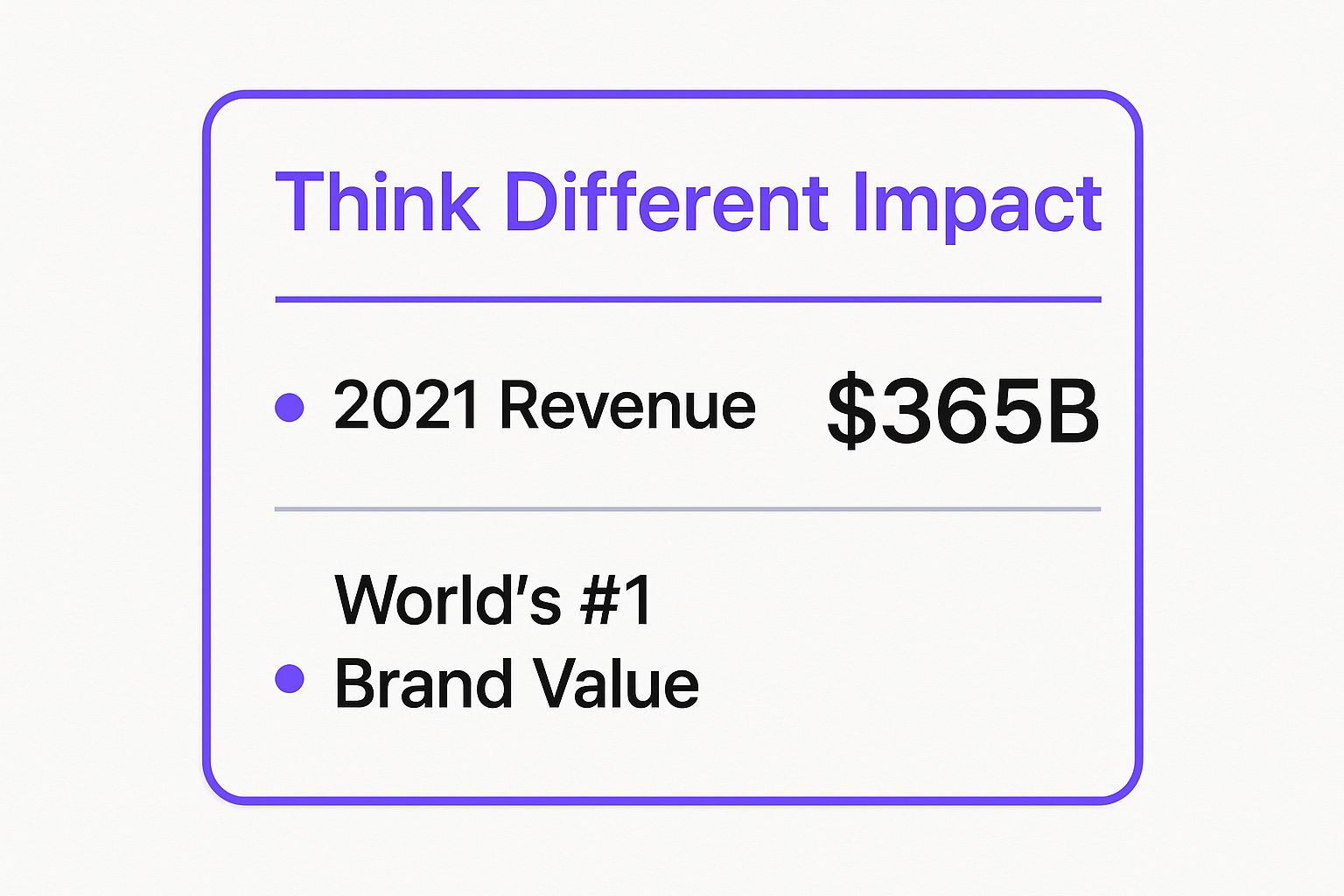7 Powerful Brand Positioning Statement Examples for 2025
A powerful brand positioning statement is the North Star for your entire marketing strategy. It's the core message that defines who you serve, what you offer, and why you are the only real choice for them. Yet, many companies struggle to create one that is clear, compelling, and consistently applied across all channels, resulting in confusing messaging and wasted marketing spend. This guide breaks down the art and science behind effective market positioning by dissecting seven iconic brand positioning statement examples.
We will move beyond surface-level slogans to analyze the strategic thinking, target audience insights, and competitive differentiation that make these brands unforgettable. You won't just see what brands like Apple, Nike, and Volvo did; you'll understand why their positioning works and how it drives every decision they make. Each example includes a detailed breakdown of the strategy, the competitive landscape they faced, and actionable takeaways you can apply directly to your own business. By the end, you'll have a replicable framework to define your unique space in the market and build a brand that connects with customers on a deeper level. This article provides the tools to craft a statement that guides your growth and solidifies your market leadership.
1. Apple - "Think Different"
Apple's "Think Different" campaign is one of the most iconic brand positioning statement examples ever created. Launched in 1997, it wasn't just a tagline; it was a complete redefinition of the company's core identity. It positioned Apple not as a computer manufacturer, but as a brand for the creative rebels, the non-conformists, and the visionaries who were changing the world.
This statement works by focusing on an emotional ideal rather than a product feature. It tapped into the human desire for self-expression, innovation, and challenging the status quo. By aligning itself with historical figures like Albert Einstein and Martin Luther King Jr., Apple created a powerful association: using Apple products meant you were part of this elite group of thinkers and creators.
Strategic Breakdown
The genius of "Think Different" lies in its execution across every brand touchpoint. The legendary "Mac vs. PC" ads didn't debate processing speeds; they personified Mac as cool, creative, and modern, while PC was portrayed as stuffy and outdated. Product launches became cultural events, reinforcing the idea that Apple was at the forefront of innovation.
Strategic Takeaway: True brand positioning goes beyond a slogan. It must be woven into the fabric of your product design, marketing, customer experience, and company culture to be authentic and effective.
Actionable Tips for Your Brand
You can adapt Apple’s approach by focusing on your audience's identity rather than just their needs.
- Define Your "Rebel": Identify the core values and aspirations of your ideal customer. What status quo are they trying to challenge? Position your brand as the tool that empowers them.
- Invest in Design and Experience: Apple proves that superior user experience and elegant design are powerful differentiators that justify premium pricing.
- Create Aspirational Content: Your marketing should celebrate the user's identity and successes, not just showcase product features. Tell stories that resonate with their worldview.
This infographic summarizes the profound financial and brand impact of Apple's consistent positioning.

The data clearly shows how this aspirational positioning translates directly into unparalleled brand value and staggering revenue, proving that selling an identity can be more powerful than selling a product.
2. Nike - "Just Do It"
Nike's "Just Do It" is a masterclass in brand positioning, transforming the company from a shoe manufacturer into a global symbol of athletic determination. Launched in 1988, this simple, powerful phrase positioned Nike not just as a provider of athletic gear, but as the inner voice of motivation for every person striving to overcome a personal challenge.

The positioning works by focusing on a universal human emotion: the internal struggle against inertia and self-doubt. It transcends professional sports, speaking directly to the everyday athlete running their first mile or the individual pushing through a tough workout. By championing the mindset of perseverance, Nike became synonymous with the very act of achieving one's potential. A strong positioning statement translates directly into a distinctive brand voice. To see more in action, you can explore other powerful brand voice examples like Nike and Apple.
Strategic Breakdown
The brilliance of "Just Do It" is its consistent and bold application. The partnership with Michael Jordan created an icon and an entire product line that embodied greatness. More recently, the "Dream Crazy" campaign featuring Colin Kaepernick reinforced Nike's willingness to stand for something bigger than sportswear, aligning the brand with courage and conviction. Every sponsorship and ad tells a story of overcoming odds.
Strategic Takeaway: Position your brand around a core human motivation. By connecting your product to a universal value like determination, courage, or creativity, you build an emotional bond that goes far beyond functional benefits.
Actionable Tips for Your Brand
You can channel Nike’s approach by becoming a source of inspiration for your customers.
- Champion Your Customer’s Journey: Feature authentic stories of real people using your product to overcome obstacles and achieve their goals. Make them the hero.
- Invest in Performance: Nike's inspirational message is backed by relentless product innovation. Ensure your product or service genuinely helps customers perform better.
- Build an Empowering Community: Use platforms like apps (e.g., Nike Training Club) or social media groups to connect customers who share similar aspirations and goals. This brand community is a key part of how to build brand awareness like a pro.
3. Volvo - "Safety First"
Volvo has built an enduring brand identity by consistently owning a single, powerful concept: safety. For decades, its positioning has centered on being the car manufacturer that prioritizes passenger protection above all else. This focus isn't just a marketing slogan; it's a core philosophy that has guided the company's engineering, innovation, and communication, making it one of the most effective brand positioning statement examples in any industry.
This statement works by appealing directly to a fundamental human need for security and protection. While other car brands chase performance, luxury, or style, Volvo has remained steadfast. By making safety its non-negotiable mission, it has carved out a unique and defensible market position, attracting families and safety-conscious buyers who see a Volvo as more than a car, but as a commitment to their well-being.
Strategic Breakdown
Volvo's "Safety First" positioning is a masterclass in authenticity. The brand backs up its promise with tangible proof, from inventing the three-point seatbelt in 1959 and making the patent available to all, to its ambitious Vision 2020 goal of having zero deaths or serious injuries in a new Volvo. This commitment is evident in its advanced crash test facilities and pioneering technologies like the City Safety collision avoidance system.
Strategic Takeaway: Your brand positioning becomes exponentially more powerful when it's proven through consistent action, not just declared in advertisements. Owning a single, crucial customer benefit and delivering on it relentlessly builds unparalleled trust and loyalty.
Actionable Tips for Your Brand
You can replicate Volvo's focus by becoming the undisputed leader in one critical area for your customers.
- Own Your Niche: Identify the single most important, and perhaps underserved, need of your target audience. Dedicate your resources to being the absolute best at solving that one problem.
- Innovate with Purpose: Your R&D and product development should directly support your core positioning. For Volvo, every innovation is a step toward greater safety.
- Communicate with Proof: Don't just tell customers you're the best; show them. Use data, testimonials, case studies, and certifications to substantiate your claims and build credibility.
- Be a Generous Leader: Like Volvo sharing its seatbelt patent, find ways to contribute to your industry. This selfless leadership reinforces your authority and commitment to the greater good, enhancing your brand's reputation.
4. Tesla - "Sustainable Luxury"
Tesla's brand positioning is a masterclass in creating a new market category by merging two previously separate ideals: sustainability and luxury performance. Instead of marketing electric vehicles (EVs) as a compromise, Tesla positioned them as the superior choice, appealing to affluent, tech-savvy consumers who want to make an environmental statement without sacrificing speed, style, or innovation.
This positioning works by directly challenging the traditional automotive landscape. It reframes the "electric car" from a practical, eco-friendly appliance into an aspirational object of desire. By delivering vehicles like the Model S that could outperform traditional gasoline-powered sports cars, Tesla shattered preconceived notions and established itself as the pinnacle of both electric technology and high-end automotive engineering.
Strategic Breakdown
Tesla’s brilliance was in making sustainability sexy. It built an entire ecosystem around its vehicles, including a proprietary Supercharger network that addressed range anxiety and over-the-air software updates that made the cars better over time. This technological moat transformed the car from a static product into a dynamic, evolving piece of technology, reinforcing its premium positioning.
Strategic Takeaway: You can dominate a new market by fusing two seemingly conflicting consumer desires. By proving that one does not have to be sacrificed for the other, you create a unique value proposition that competitors struggle to replicate.
Actionable Tips for Your Brand
You can apply Tesla's category-defining strategy by identifying and merging distinct value propositions.
- Marry Your Mission with Performance: Don't just sell your eco-friendly or ethical mission; demonstrate how it leads to a superior product. Connect your brand's purpose directly to a tangible customer benefit, like better performance, durability, or design.
- Build an Exclusive Ecosystem: Create supporting products, services, or communities that enhance the core offering. This builds customer loyalty and creates a barrier to entry for competitors.
- Leverage Technology as a Differentiator: Use innovative technology not just as a feature but as a core part of your brand's identity. Position your product as the smartest, most future-forward choice in its category.
5. Dove - "Real Beauty"
Dove's "Real Beauty" campaign represents a seismic shift in the beauty industry, making it one of the most powerful brand positioning statement examples of the modern era. Launched in 2004, it repositioned Dove from a simple soap brand to a cultural advocate for self-esteem. The brand boldly challenged the narrow, unattainable standards of beauty perpetuated by the media, instead celebrating real women in all their diversity.
This statement works by connecting with a deep-seated social and emotional pain point. It identified the negative impact unrealistic beauty ideals have on women's self-worth and positioned Dove as the antidote. By championing authenticity, Dove created a powerful movement that resonated with millions, transforming customers into loyal brand evangelists who felt seen and validated.
Strategic Breakdown
The brilliance of "Real Beauty" is its authenticity and long-term commitment. Campaigns like the viral "Real Beauty Sketches" video demonstrated how women perceive themselves more critically than strangers do, sparking a global conversation. The brand also launched the Dove Self-Esteem Project, an educational initiative to help young people build body confidence, cementing its purpose beyond product sales.
Strategic Takeaway: Positioning your brand around a powerful social mission can build immense customer loyalty. However, it requires unwavering commitment and authentic action, not just a marketing slogan. Your mission must be reflected in your company's actions and partnerships.
Actionable Tips for Your Brand
You can adapt Dove’s purpose-driven approach by aligning your brand with a cause that genuinely matters to your target audience.
- Find Your Authentic Mission: Identify a social or cultural issue that aligns with your brand's values and your audience's concerns. Ensure your commitment is genuine.
- Invest in Emotional Storytelling: Create content that tells human stories rather than just selling products. As explained in guides on brand storytelling in digital marketing, this approach forges a much deeper connection with your audience.
- Back It Up with Action: Launch initiatives, partner with relevant organizations, or change internal policies to prove your commitment. For Dove, this meant diverse casting and creating educational resources.
- Foster Community Dialogue: Use your platform to start conversations around your mission, encouraging user-generated content and creating a community of advocates.
6. Patagonia - "Environmental Activism"
Patagonia provides one of the most powerful brand positioning statement examples by transcending the role of a product manufacturer. It isn't just an outdoor apparel company; it's an environmental activist organization that happens to sell high-quality gear. This positioning is built on a foundation of value-driven action, attracting consumers who want their purchasing power to align with their ethical and environmental beliefs.
The brand's mission, "We're in business to save our home planet," is not a tagline but a guiding principle that dictates every business decision. This authentic commitment allows Patagonia to connect with its audience on a deeply emotional level, fostering a community of advocates, not just customers. Campaigns like the audacious "Don't Buy This Jacket" ad challenged consumerism itself, solidifying Patagonia's role as a mission-first, profit-second entity.

Strategic Breakdown
Patagonia’s strategy proves that radical transparency and unwavering commitment to a cause can be a company's greatest asset. Initiatives like founding the 1% for the Planet alliance, where members donate 1% of sales to environmental nonprofits, provide tangible proof of its mission. The Worn Wear program, which encourages repair and resale, directly counteracts the fast-fashion model and reinforces the brand's dedication to sustainability over short-term sales.
Strategic Takeaway: When your brand's core values are authentically integrated into your business model, your positioning becomes unshakable. Customers buy into the mission, and the products become a symbol of their participation in that mission.
Actionable Tips for Your Brand
You can build a similarly powerful, mission-driven brand by making your values the core of your strategy.
- Embed Your Mission: Go beyond a mission statement on your website. Ensure your values influence your supply chain, hiring practices, product development, and marketing.
- Invest in Your Cause: Dedicate a meaningful portion of your revenue or resources to the cause you champion. This demonstrates commitment and builds credibility.
- Empower Your Community: Don't just sell to your audience; involve them. Create programs and campaigns that allow customers to participate directly in your brand's mission.
7. Southwest Airlines - "Low-Cost, High-Spirit"
Southwest Airlines masterfully carved out its niche by positioning itself as the airline that makes flying accessible and enjoyable. Its positioning rejects the industry trade-off that low cost must mean poor service. Instead, it built a brand promise around offering affordable fares while delivering a uniquely positive and spirited customer experience, effectively democratizing air travel for the masses.
This statement works by combining a functional benefit (low cost) with a powerful emotional differentiator (high spirit). While other budget airlines focused solely on price, often leading to a race to the bottom in terms of service, Southwest built its identity on its people. The "LUV" culture, humorous flight attendants, and friendly service transformed a commodity into a memorable experience.
Strategic Breakdown
Southwest’s positioning is a masterclass in operational alignment. Every decision, from using a single aircraft model (the Boeing 737) to its point-to-point routes, is designed to keep costs low and efficiency high. This operational simplicity allows them to pass savings to customers without sacrificing their core promise of reliability and a positive attitude. Marketing campaigns like "Bags Fly Free" directly attack competitors' pain points, reinforcing their value proposition.
Strategic Takeaway: Your company culture is not separate from your brand positioning; it is the engine that brings it to life. Empowering employees to embody the brand's personality creates authentic and unforgettable customer interactions that marketing alone cannot replicate.
Actionable Tips for Your Brand
You can adapt Southwest’s culture-driven approach to stand out in a crowded market.
- Define Your Service Personality: What is the emotional signature of your customer experience? Is it fun, empowering, reassuring? Train and empower your team to deliver that feeling consistently.
- Simplify to Amplify: Identify operational complexities that add cost but little value to your customer. Streamlining processes can free up resources to invest in what truly matters.
- Communicate Value Clearly: Don't just state your low price; explain how you deliver that value. This builds trust and defends your position against competitors. Many successful digital marketing strategies for small businesses are built on this principle of clear value communication.
Brand Positioning Statement Comparison
| Apple - "Think Different" | High – requires cohesive innovation and design | High – heavy investment in design, marketing | Strong emotional loyalty; premium pricing; brand differentiation | Premium tech products targeting creative professionals | Emotional brand loyalty; aspirational marketing |
|---|---|---|---|---|---|
| Nike - "Just Do It" | Moderate to High – ongoing athlete stories | High – marketing, athlete endorsements | Broad motivation appeal; emotional connection; premium performance | Athletic products for all levels, diverse sports markets | Inspires broad audience; supports premium pricing |
| Volvo - "Safety First" | Moderate – focus on safety tech and consistency | Moderate to High – R&D in safety features | Trusted safety reputation; appeals to families; industry influence | Family cars; safety-conscious consumers | Strong differentiation; builds trust and reliability |
| Tesla - "Sustainable Luxury" | High – requires tech innovation and infrastructure | High – R&D, charging network, software | Market leader in luxury EVs; strong brand loyalty; sustainability impact | Luxury EV buyers valuing performance and environment | First-mover advantage; tech and sustainability lead |
| Dove - "Real Beauty" | Moderate – inclusive, authentic marketing needed | Moderate – marketing, research | Brand loyalty through shared values; positive social impact | Beauty products for diverse, self-esteem focused consumers | Emotional connection; social responsibility focus |
| Patagonia - "Environmental Activism" | High – business aligned with activism mission | Moderate to High – environmental initiatives | Loyal, purpose-driven customers; premium pricing; industry influence | Outdoor gear buyers with strong environmental values | Authentic environmental credentials; strong loyalty |
| Southwest Airlines - "Low-Cost, High-Spirit" | Moderate – operational simplicity crucial | Moderate – efficient operations, culture | High passenger volume; loyal price-conscious travelers | Budget travelers wanting friendly service | Clear value proposition; strong company culture |
From Examples to Execution: Your Next Steps
We've explored a powerful lineup of brand positioning statement examples, moving from Apple's rebellious creativity to Volvo's unwavering commitment to safety. Each deep dive reveals a fundamental truth: a strong brand position isn't just a clever tagline; it's the strategic core of a successful business. It's the "why" behind every product decision, marketing campaign, and customer interaction.
The common thread connecting giants like Nike, Tesla, and Dove is not just immense marketing budgets, but a relentless pursuit of clarity. They have mastered the art of defining their unique space in the consumer's mind, making their brands the only logical choice for their specific audience. This clarity provides a powerful filter, ensuring every action they take reinforces their core promise.
Key Insights from the Examples
Reflecting on the strategies of Patagonia’s activism or Southwest Airlines’ high-spirit, low-cost model, several critical patterns emerge. The most successful brands don’t try to be everything to everyone. Instead, they excel by focusing on a few core principles:
- Radical Audience Focus: They know their target customer intimately, not just their demographics but their values, fears, and aspirations. Dove’s "Real Beauty" campaign succeeded because it addressed a deep-seated insecurity its audience felt.
- Unwavering Consistency: The brand promise is delivered at every single touchpoint. Volvo doesn't just talk about safety in ads; it engineers its cars to be the safest on the road and lobbies for industry-wide safety improvements.
- Authentic Differentiation: Their unique value isn't a fabricated marketing angle; it's a genuine part of their company DNA. Patagonia’s environmental mission is baked into its supply chain, product design, and corporate philanthropy.
Your Action Plan for Brand Positioning
Now, it's time to transition from analysis to action. Use the frameworks and takeaways from these brand positioning statement examples to audit and refine your own brand strategy. This isn't a passive exercise; it requires honest and critical thinking.
Start by asking these foundational questions:
Who is our ideal customer? Go beyond surface-level descriptions. What core problem are they trying to solve that we are uniquely equipped to handle?
What is our non-negotiable promise? Identify the one thing you do better than anyone else. Is it innovation, service, value, or something else entirely?
Why should they believe us? What is your "reason to believe"? This could be proprietary technology, a unique process, customer testimonials, or a foundational company ethos.
Is our position truly distinct? If your top competitor could use the exact same positioning statement, it’s not sharp enough. You must own a specific and defensible territory in the market.
Crafting a powerful positioning statement is an ongoing commitment, not a one-time project. It’s a strategic compass that guides your entire organization toward a unified goal: building a memorable, beloved, and profitable brand. For those looking to explore this concept further, seeing a wider variety of approaches can be incredibly helpful. To gain further insights and inspiration, delve into these additional powerful Top Brand Positioning Examples.
Ready to move from theory to execution? At Rebus, we specialize in transforming brand potential into market leadership by crafting and implementing precise positioning strategies across every digital channel. If you need a partner to help you define your unique place in the market and captivate your ideal audience, we're ready to help.
